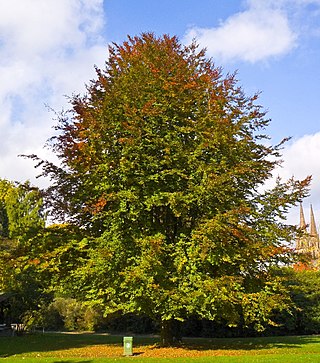
The Fagaceae are a family of flowering plants that includes beeches, chestnuts and oaks, and comprises eight genera with about 927 species. Fagaceae in temperate regions are mostly deciduous, whereas in the tropics, many species occur as evergreen trees and shrubs. They are characterized by alternate simple leaves with pinnate venation, unisexual flowers in the form of catkins, and fruit in the form of cup-like (cupule) nuts. Their leaves are often lobed, and both petioles and stipules are generally present. Their fruits lack endosperm and lie in a scaly or spiny husk that may or may not enclose the entire nut, which may consist of one to seven seeds. In the oaks, genus Quercus, the fruit is a non-valved nut called an acorn. The husk of the acorn in most oaks only forms a cup in which the nut sits. Other members of the family have fully enclosed nuts. Fagaceae is one of the most ecologically important woody plant families in the Northern Hemisphere, as oaks form the backbone of temperate forest in North America, Europe, and Asia, and are one of the most significant sources of wildlife food.
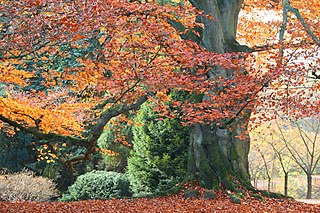
Beech (Fagus) is a genus of deciduous trees in the family Fagaceae, native to temperate Europe, Asia, and North America. Recent classifications recognize 10 to 13 species in two distinct subgenera, Engleriana and Fagus. The Engleriana subgenus is found only in East Asia, distinctive for its low branches, often made up of several major trunks with yellowish bark. The better known Fagus subgenus beeches are high-branching with tall, stout trunks and smooth silver-grey bark. The European beech is the most commonly cultivated.

Fagus sylvatica, the European beech or common beech is a deciduous tree belonging to the beech family Fagaceae.

Fagus grandifolia, the American beech or North American beech, is a species of beech tree native to the eastern United States and extreme southeast of Canada.
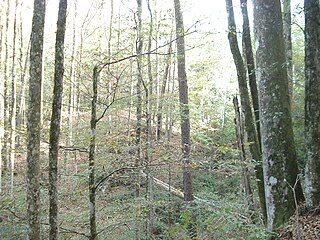
Fagus mexicana, the Mexican beech or haya, is a species of beech endemic to northeastern and central Mexico, where it occurs from Nuevo León, Tamaulipas south to Hidalgo, Veracruz and Puebla. It is restricted to Tropical montane cloud forests in the Sierra Madre Oriental.
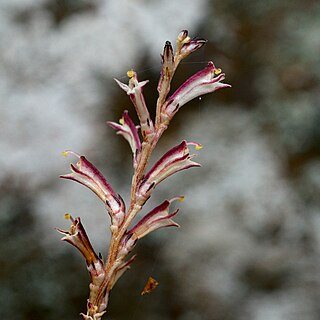
Epifagus virginiana, commonly called beech drops, is an obligate parasitic plant which grows and subsists on the roots of American beech. It is a member of the family Orobanchaceae. The genus Epifagus is monotypic—containing only E. virginiana. The name Epifagus derives from Greek "epi" meaning "on" or "upon", and "Fagus" which is the genus name of beech.

Beech bark disease is a disease that causes mortality and defects in beech trees in the eastern United States, Canada and Europe. In North America, the disease occurs after extensive bark invasion by Xylococculus betulae and the beech scale insect, Cryptococcus fagisuga. Through a presently unknown mechanism, excessive feeding by this insect causes two different fungi to produce annual cankers on the bark of the tree. The continuous formation of lesions around the tree eventually girdles it, resulting in canopy death. In Europe, N. coccinea is the primary fungus causing the infection. Infection in European trees occurs in the same manner as it does in North American trees. Though the disease still appears in Europe, it is less serious today than it once was.

Kretzschmaria deusta, commonly known as brittle cinder, is a fungus and plant pathogen found in temperate regions of the Northern Hemisphere on broad-leaved trees, also found in Argentina, South Africa, and Australia.

Phytophthora kernoviae is a plant pathogen that mainly infects European beech and Rhododendron ponticum. It was first identified in 2003 in Cornwall, UK when scientists were surveying for the presence of Phytophthora ramorum. This made it the third new Phytophthora species to be found in the UK in a decade. It was named Phytophthora kernoviae after the ancient name for Cornwall, Kernow. It causes large stem lesions on beech and necrosis of stems and leaves of Rhododendron ponticum. It is self-fertile. It has also been isolated from Quercus robur and Liriodendron tulipifera. The original paper describing the species, stated it can infect Magnolia and Camellia species, Pieris formosa, Gevuina avellana, Michelia doltsopa and Quercus ilex. Since then many other plants have been identified as natural hosts of the pathogen. Molecular analysis has revealed that an infection on Pinus radiata, recorded in New Zealand in 1950, was caused by P. kernoviae. The pathogen was also noted on Drimys winteri, Gevuina avellana, Ilex aquifolium, Quercus ilex, Vaccinium myrtillus, Hedera helix, Podocarpus salignas.
Globodera tabacum, commonly known as a tobacco cyst nematode, is a plant parasitic nematode that mainly infests the tobacco plant, but also plants in family Solanaceae.
Cryptococcus fagisuga, commonly known as the beech scale or woolly beech scale, is a felted scale insect in the superfamily Coccoidea that infests beech trees of the genus Fagus. It is associated with the transmission of beech bark disease because the puncture holes it makes in the bark allow entry of pathogenic fungi which have been identified as Nectria coccinea var. faginata and sometimes Nectria galligena.
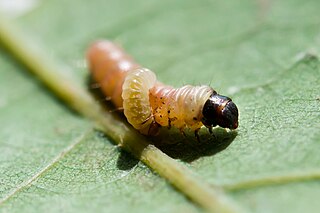
Psilocorsis cryptolechiella is a moth of the family Depressariidae. It is found in the United States, including Alabama, Illinois, Massachusetts, Pennsylvania and South Carolina.
Monodominance is an ecological condition in which more than 60% of the tree canopy comprises a single species of tree. Monodominant forests are quite common under conditions of extra-tropical climate types. Although monodominance is studied across different regions, most research focuses on the many prominent species in tropical forests. Connel and Lowman, originally called it single-dominance. Conventional explanations of biodiversity in tropical forests in the decades prior to Connel and Lowman's work either ignored monodominance entirely or predicted that it would not exist.

The South American palm weevil, Rhynchophorus palmarum, is a species of snout beetle. The adults are relatively large black beetles of approximately one and a half inch in length, and the larvae may grow to two inches in length.
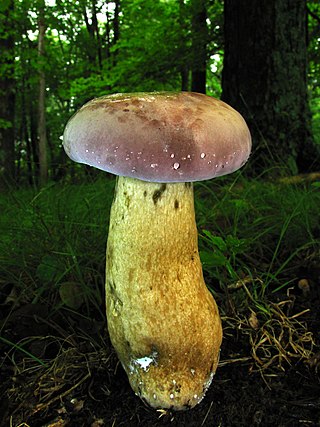
Tylopilus rubrobrunneus, commonly known as the reddish brown bitter bolete, is a bolete fungus in the family Boletaceae. It was first described scientifically in 1967 by Samuel J. Mazzer and Alexander H. Smith from collections made in Michigan. It is found in the United States; the bolete was reported from a Mexican beech forest in Hidalgo, Mexico in 2010.

Boletus pallidus is an edible species of bolete fungus. It was described by Charles Christopher Frost in 1874. The bolete was reported from a Mexican beech forest in Hidalgo, Mexico in 2010.

Leccinellum albellum is a species of bolete fungus in the family Boletaceae. Originally described by Charles Horton Peck as a species of Boletus, and, after 1945, usually considered a species of Leccinum, it was transferred to the newly created genus Leccinellum in 2003. The bolete was reported from a Mexican beech forest in Hidalgo, Mexico in 2010.
Boletus roseolateritius is a bolete fungus found in the southern United States and northeast Mexico. It was described as a new species in 2003 by Alan Bessette, Ernst Both, and Dail Dunaway. The type collection was made in Mississippi, where it was found growing on the ground under American beech, near hickory and oak. The bolete was reported from a Mexican beech forest in Hidalgo, Mexico in 2010.

Beech leaf disease is a newly discovered lethal disease of beech trees believed to be caused by the nematode Litylenchus crenatae mccannii. The symptoms of the disease appear as a dark green, interveinal banding pattern on the lower canopy foliage, eventually spreading throughout the tree. The symptoms appear to progress through the buds and no new leaves are produced. This eventually results in the death of the tree. The disease has the potential to drastically alter the Eastern deciduous forests of the United States on its own and through potential compounding disease effects.
Litylenchus is a genus of nematodes belonging to the family Anguinidae. The genus is found in North America and Japan.















